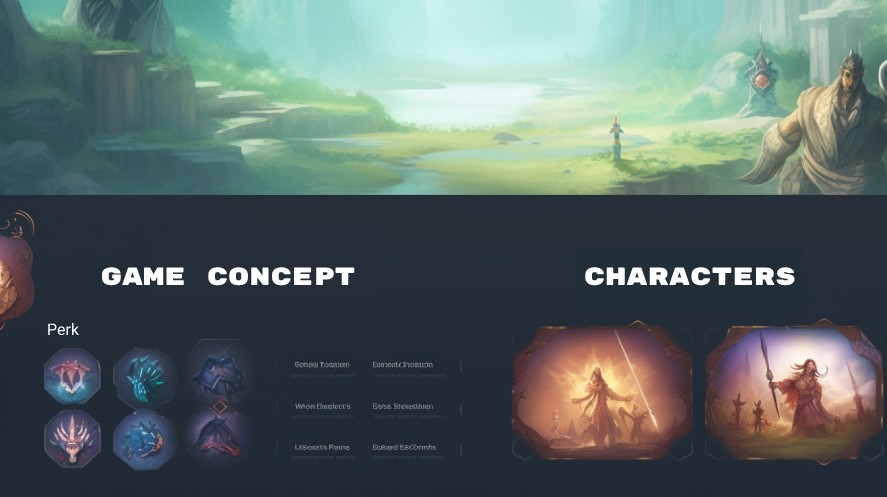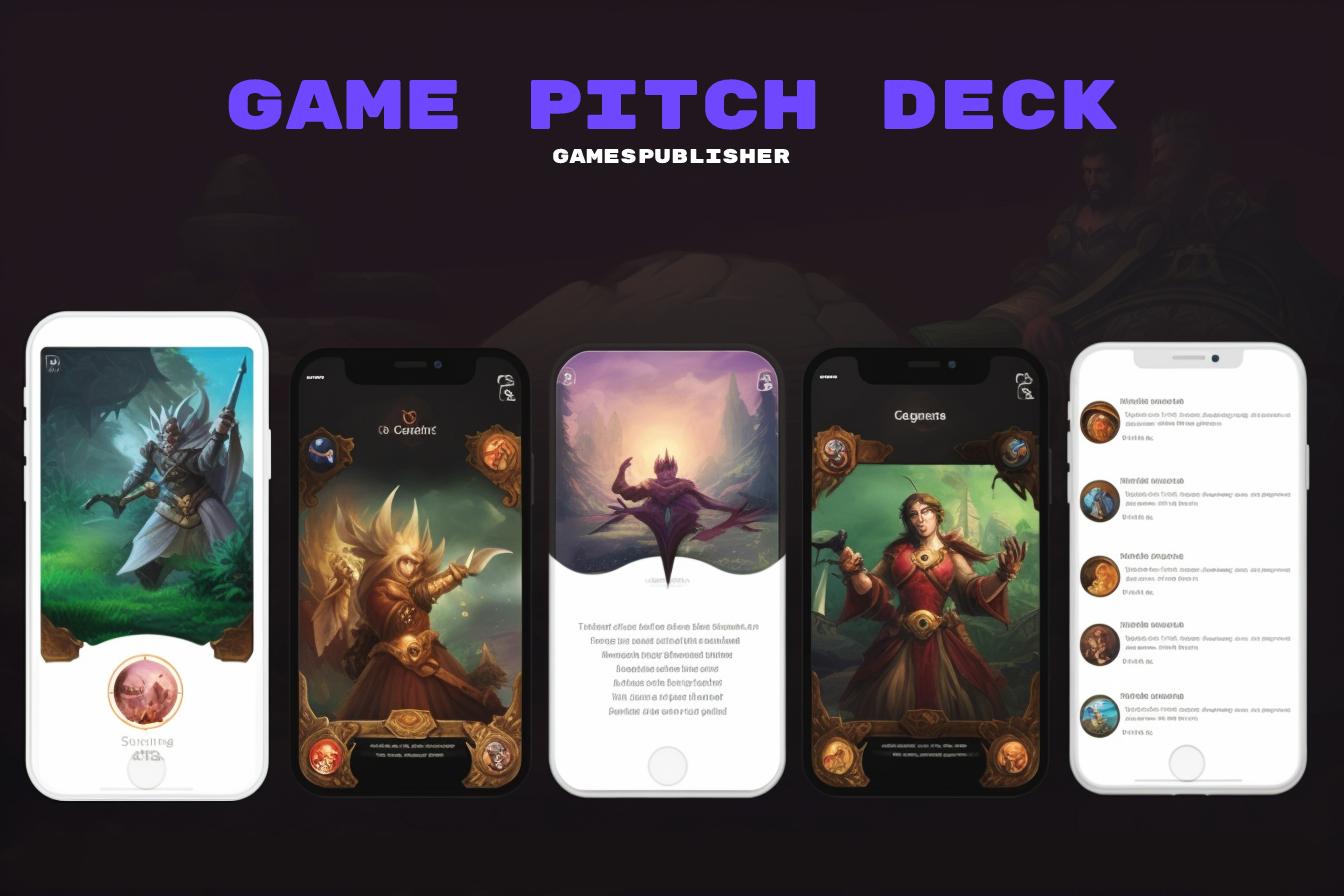A compelling game development pitch deck is essential in the competitive game development landscape.
Whether you’re an indie developer or part of a larger studio, a well-crafted pitch game deck can make all the difference in attracting stakeholders, publishers, or investors.
If you’re looking to take your game development career to the next level, understanding and creating an effective pitch deck is a must.
What is a Pitch Deck in Game Development?
A pitch deck is a concise presentation that provides an overview of your game and its potential.
It visually represents your game concept, showcasing its unique selling points, target audience, monetization strategy, development timeline, team and their skills, budget, funding requirements, and more.

Think of it as your game’s elevator pitch condensed into a captivating slide deck.
Game dev pitch decks serve as a comprehensive introduction to your game, capturing the attention of stakeholders and conveying its potential value.
If you want to learn more about game development, check out this “How To Get Into Game Development (10 Steps)” article.
Importance of a Pitch Deck for Game Developers
Pitching games not only help shape the development of the game from the initial stages but also serves as a persuasive tool to convince stakeholders, publishers, or investors about the game’s potential.
A well-crafted pitch deck can shape the development process. This clarity ensures that the development process remains focused and aligned with the initial vision.
Another benefit of a game pitch deck is to attract stakeholders and investors.
Pitch decks play a vital role in securing funding or partnerships. They provide a comprehensive overview of the game’s potential, enticing stakeholders and investors to get on board with the project.
Crafting a Compelling Pitch Deck
To create a compelling game pitch deck that captures the attention of both big and indie game publishers, it’s essential to pay careful attention to each step of the process.

Let’s break down the structure of a pitch deck!
1. Game Concept
Clearly define your game’s concept, encompassing its core mechanics, genre, and unique features.
Describe how your game stands out in the market, offering players a fresh and exciting experience. Use concise and captivating language to vividly describe the gameplay, game resources, and overall vision.
2. Target Audience
Identify your target audience and demonstrate a deep understanding of their preferences, needs, and behaviors. Showcase your research and data that supports the market viability of your game.
By effectively communicating your target audience, you show stakeholders that you have a well-defined market segment to tap into.
3. Unique Selling Points
Highlight the unique aspects of your game that set it apart from competitors. Showcase what makes it fun, engaging, and memorable for players.
Whether it’s an innovative gameplay mechanic, immersive storytelling, or striking visual game design, emphasize the elements that make your game stand out in a crowded market.
4. Market Research
Conduct thorough market research and provide insights into the market landscape. Include trends, competitor analysis, and potential opportunities.
Demonstrate a strategic approach to game development by showcasing an understanding of the market’s demands and how your game aligns with them.
5. Monetization Strategy
Outline your monetization plans, showcasing how your game can generate revenue.
Whether through in-app purchases, subscriptions, advertisements, or other models, present a well-thought-out strategy that aligns with your target audience and game concept. Provide data and industry research to support your chosen monetization methods.
6. Development Timeline
Present a realistic development timeline that outlines the different milestones and estimated release dates.
This demonstrates your project management skills and gives stakeholders a clear understanding of the timeline and progress. Ensure the timeline is achievable and allows for flexibility to accommodate unforeseen challenges.
7. Team and their Skills
Introduce your development team and highlight their skills, expertise, game dev tools, and accomplishments. Emphasize their experience in the industry and showcase how their collective talent supports the successful execution of the game.
This instills confidence in stakeholders, showing that you have a capable team behind the project.
8. Budget and Funding Requirements
Provide a comprehensive budget breakdown for game development, marketing, and other aspects. Clearly state your funding requirements and potential return on investment. Illustrate how the allocated budget will be utilized to ensure the game’s success and profitability.
This financial transparency helps stakeholders assess the project’s viability.
And that’s how to pitch a video game idea!
Remember to keep the pitch deck concise, visually appealing, and easy to understand. Use graphics, mock-ups, and concept art to support your presentation and engage the audience.
Case Studies: Successful Game Development Pitch Decks
Let’s explore some real-life examples of successful pitch decks that contributed to the success of notable games:
Example 1: Bioshock Pitch Deck
The BioShock pitch deck was created in 2002 as part of the initial pitch for the game. The pitch deck played a crucial role in capturing the attention and support of stakeholders, ultimately leading to the successful development and release of the game.
- Product Type: Gaming
- Business Model: B2C
- Pitch Year: 2002
- Backed by: 2K Games
Game Concept
The pitch deck clearly defined the game’s concept as a first-person shooter set in an immersive and atmospheric underwater city called Rapture. It highlighted the game’s core mechanics, blending action, exploration, and a compelling narrative.
Target Audience
The pitch deck identified the target audience as gamers who were drawn to immersive storytelling, atmospheric environments, and engaging gameplay.
By understanding the preferences and interests of this audience, the pitch deck demonstrated the market viability of BioShock and its potential to resonate with players.
Monetization Strategy
The pitch deck outlined the monetization strategy for BioShock, focusing on the traditional business-to-consumer (B2C) model. It presented plans for retail sales, digital distribution, and potential downloadable content (DLC) to generate revenue.
Example 2: Kryptomon Pitch Deck
The Kryptomon pitch deck, created in 2022, played a pivotal role in securing funding and support for the development of this innovative gaming project.
Kryptomon is an NFT-powered game that combines the beloved elements of classic games like Pokemon and Tamagotchi with the ownership properties found in popular NFT projects like CryptoKitties.
- Product Type: Gaming
- Business Model: B2C
- Pitch Year: 2022
- Backed by: Series A
- Funding: $10M
Game Concept
The Kryptomon pitch deck outlined a groundbreaking game concept that leverages NFT technology. Players can collect and train virtual creatures called Kryptomons, each represented as a unique and tradable non-fungible token.
The game draws inspiration from the beloved mechanics of Pokemon and Tamagotchi, allowing players to nurture and evolve their Kryptomons while engaging in battles and exploring a vibrant virtual world.
Target Audience
The pitch deck identified the target audience as gamers who are passionate about traditional gaming experiences and intrigued by the potential of blockchain technology and NFTs.
By targeting this niche, Kryptomon aimed to appeal to both gaming enthusiasts and crypto enthusiasts, broadening its market appeal and potential user base.
Unique Selling Points
The pitch deck highlighted the fusion of classic gameplay mechanics with the cutting-edge technology of NFTs, providing players with true ownership and the ability to trade their virtual assets.
The combination of nostalgia-inducing gameplay, the excitement of collectible NFTs, and the potential for value appreciation made Kryptomon a compelling proposition for gamers and crypto enthusiasts alike.
Market Research
The pitch deck included comprehensive market research, showcasing insights into the growing demand for blockchain-based games and NFTs. It analyzed the success of popular NFT projects like CryptoKitties and the increasing interest in owning unique digital assets.
The market research supported the strategic positioning of Kryptomon as a game that taps into these trends, offering an engaging and lucrative gaming experience.
Monetization Strategy
The pitch deck outlined a robust monetization strategy for Kryptomon, focusing on the traditional business-to-consumer (B2C) model. It showcased the potential revenue streams, including initial game purchases, in-game transactions, and a marketplace for trading Kryptomon NFTs.
The deck highlighted the unique opportunity for Kryptomon to generate revenue through game sales and the value appreciation of its NFT assets.
Development Timeline
The pitch deck provided a detailed development timeline, outlining the different stages of game development and the estimated release date. It showcased the team’s game development expertise and commitment to delivering a polished and engaging gaming experience within the specified timeframe.
Team and Backing
The pitch deck introduced the talented development team behind Kryptomon and emphasized their experience in both gaming and blockchain technology.
It also highlighted the backing of a Series A investment round, securing $10 million in funding. The strong team and financial support instilled confidence in the project’s execution and success.
How a Pitch Deck Can Propel a Game Developer’s Career
Crafting a comprehensive pitch deck can unlock various opportunities for game developers.

A well-executed pitch deck can:
Secure Funding
A compelling pitch deck increases the chances of securing funding from investors, game publishers, or crowdfunding platforms. It demonstrates your game’s potential and the return on investment for stakeholders.
Attract Talent and Collaboration
A strong pitch deck can help attract talented individuals or studios interested in collaborating on your game. It showcases your vision and professionalism, making others eager to be a part of the project.
Serve as a Roadmap
A pitch deck acts as a roadmap for the game development process. It ensures the team remains focused on the initial vision, guiding decision-making throughout the development cycle.
Showcase Professionalism
A well-crafted pitch deck demonstrates professionalism and attention to detail. It creates a positive impression of you as a developer, increasing your credibility in the video game industry.
Conclusion
In the competitive game development and game publishing world, a well-crafted pitch deck is a powerful tool that can open doors and propel your career forward.
By understanding the elements that make a pitch deck effective and studying successful examples, you can create a compelling pitch deck that captivates stakeholders and drives the success of your game.
Utilize the insights provided in this article to create a pitch deck that showcases your game’s potential and sets you on the path to success.

